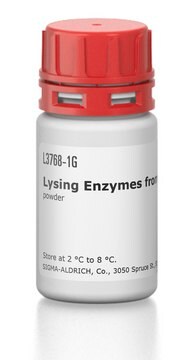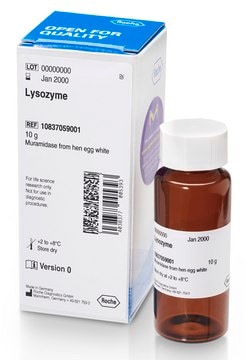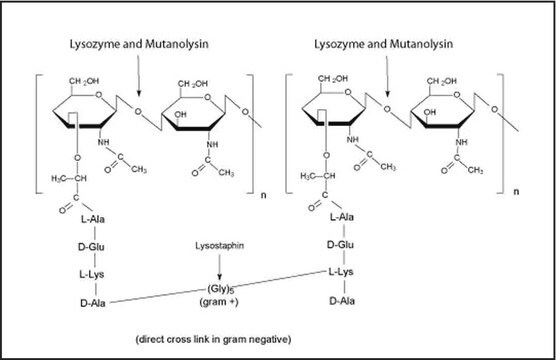L4025
Lyticase from Arthrobacter luteus
lyophilized powder, ≥200 units/mg solid
Sinónimos:
(1,3)-β-D-Glucan endohydrolase, 1,3-β-Glucan glucohydrolase, Bacterial lyticase, Lysing enzyme
About This Item
Productos recomendados
biological source
bacterial (Arthrobacter luteus)
Quality Level
form
lyophilized powder
specific activity
≥200 units/mg solid
technique(s)
cell based assay: suitable
suitability
suitable for cell lysis
application(s)
diagnostic assay manufacturing
storage temp.
−20°C
¿Está buscando productos similares? Visita Guía de comparación de productos
Application
- as a component in spheroplasting buffer to prepare yeast nuclear extracts
- for digestion in sample preparation for β-glucan enzymatic assay using yeast
- to lyse cells for RNA isolation
Biochem/physiol Actions
Unit Definition
Other Notes
signalword
Danger
hcodes
pcodes
Hazard Classifications
Resp. Sens. 1
Storage Class
11 - Combustible Solids
wgk_germany
WGK 3
flash_point_f
Not applicable
flash_point_c
Not applicable
ppe
Eyeshields, Gloves, type N95 (US)
Certificados de análisis (COA)
Busque Certificados de análisis (COA) introduciendo el número de lote del producto. Los números de lote se encuentran en la etiqueta del producto después de las palabras «Lot» o «Batch»
¿Ya tiene este producto?
Encuentre la documentación para los productos que ha comprado recientemente en la Biblioteca de documentos.
Protocolos
This procedure may be used for the determination of Lyticase activity using Baker’s yeast as the substrate.
Nuestro equipo de científicos tiene experiencia en todas las áreas de investigación: Ciencias de la vida, Ciencia de los materiales, Síntesis química, Cromatografía, Analítica y muchas otras.
Póngase en contacto con el Servicio técnico







